
Dirty toilets not only house thousands of bacteria in them but can also spread multiple infections, compromising the health of you and your loved ones. However, with so many eco-friendly cleaning solutions, what works best when it comes to dirty, stained toilets?
The best eco-friendly cleaners for toilets include vinegar, bleach, Clorox, and even Borax. However, some of these solutions can be quite strong for your porcelain toilet, and therefore, they need to be diluted before being used.
Regularly cleaning your toilet with an eco-friendly cleaning solution allows you to flush away disease-causing germs and host a healthy and hygienic environment. In addition to getting rid of existing bacteria, an eco-friendly cleaner doesn’t produce harmful chemicals after dissolving in water, promising clean and healthy water resources.
Can You Use Vinegar To Clean Toilets?

Vinegar is used everywhere in our home, from cooking to cleaning, making it an always-available solution. Since vinegar acts as a great disinfectant for most surfaces, is it efficient in cleaning away germs and stains from toilet bowls as well?
Yes, vinegar is the perfect eco-friendly solution to sanitize your toilet and remove stains. This is mainly owed to its acidic nature which not only wipes off any bacteria from the toilet bowl but also allows it to soften up tough stains for removal.
How To Clean Your Toilet With Vinegar
Vinegar is among the most efficient cleaners for bacteria inhabiting toilets. However, if not used correctly, vinegar has the potential to damage your toilet seat and any plastic parts it comes in contact with.
Step 1: Rinse the toilet bowl thoroughly by flushing it once to make it easy to scrub later
Step 2: Start by pouring a generous glug of vinegar into the toilet bowl. Moreover, you can also sprinkle some baking soda on top of the vinegar if you want even better results.
Step 3: When the mixture starts bubbling up, start scrubbing the toilet bowl with your toilet brush. Don’t forget to scrub under the rim as well!
Step 4: Let it soak for at least 30 minutes and then flush the solution to own a clean and hygienic toilet.
Can You Use Malt Vinegar To Clean Toilets?
Malt vinegar is milder on the palette and a less acidic substitute for regular vinegar. Although it’s still strong enough to retain its bacteria-killing nature to some extent, not everyone can go through that certain chip-chop smell of the malt vinegar. So, can you use malt vinegar to wipe away dirt from your toilet?
Technically, yes, you can use malt vinegar for cleaning your toilet but experts advise that using malt vinegar makes your toilet prone to decolorization. In addition, the less acidic nature of the liquid can cause bacteria build ups to survive the sanitization process.
Apart from being less stronger than regular vinegar, malt vinegar also costs more and needs to be used in excessive amounts to make any difference in your toilet. Therefore it’s recommended to only use malt vinegar when there’s nothing else available.
This article and its contents are owned by Wabi Sabi Group and was first published on 06/13/2022.
Can You Use Water To Clean Toilets?
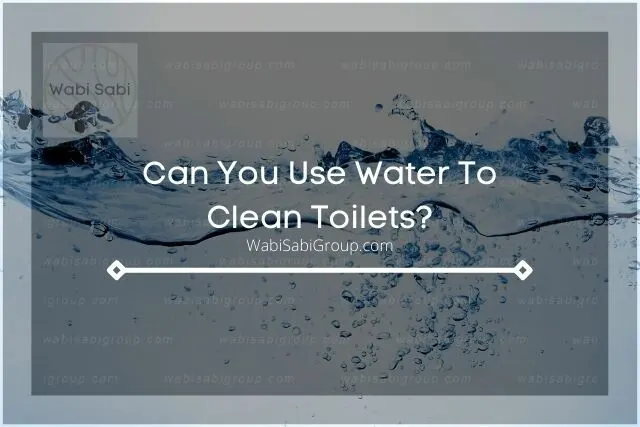
Water is the most eco-friendly way of cleaning and rinsing most surfaces. Even though its non-acidic nature when cleaned thoroughly, it can remove streaks and unhygienic odors from various surfaces. However, is water strong enough to rinse away impurities from your toilet bowl?
The most eco-friendly way is to use water to clean the toilet. A proper scrub with water can remove light stains and odors from the toilet bowl making it the easiest way to clean your toilet. However, water can’t kill the huge number of bacteria inhabiting the toilet bowl so it’s not safer than other substitutes
Advantages Of Using Water To Clean Toilets
Water may not be the strongest cleaning solution out there, but it sure is eco-friendly. Here are some advantages to make you feel good about yourself if you’re using water to clean out your toilet bowls:
- Cleaning your toilet with water bears zero cost on your pocket
- No special instructions are needed to use, just thoroughly wash, scrub and then flush to get a clean toilet
- Although water doesn’t promise about killing bacteria, regular sanitation with it can prevent the build-up of bacteria from the beginning.
- Cleaning your toilet with water bears zero cost on your pocket
- No special instructions are needed to use, just thoroughly wash, scrub and then flush to get a clean toilet
- Although water doesn’t promise about killing bacteria, regular sanitation with it can prevent the build-up of bacteria from the beginning.
- Cleaning your toilet with water bears zero cost on your pocket
- No special instructions are needed to use, just thoroughly wash, scrub and then flush to get a clean toilet
- Although water doesn’t promise about killing bacteria, regular sanitation with it can prevent the build-up of bacteria from the beginning.
Can You Use Baking Soda To Clean Toilets?
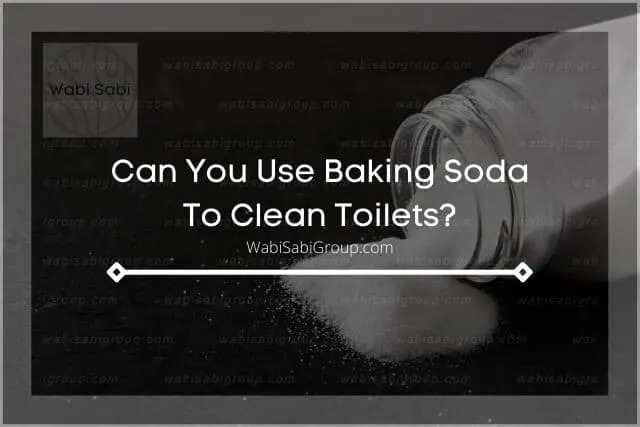
Baking soda is not only a pretty common cleaning agent but rather a strong one. Being alkaline in nature, baking soda effortlessly dissolves germs and grime when treated with water. While baking soda is a completely eco-friendly and non-toxic cleaning alternative, is it effective against scum-filled toilets?
Yes, baking soda is a great solution for removing stains and scum from your toilet. Moreover, due to its alkaline nature, baking soda is gently abrasive and can remove stinky odors, deodorizing the toilet and making it sparkling clean.
Correct Method Of Cleaning Your Toilet With Baking Soda
There are two basic ways of using baking soda to clean your toilet; either pair it up with water or some acidic substance like vinegar.
Baking Soda with Vinegar
If you use baking soda with vinegar, you’ll find it easier to stick to your toilet rather than going down the flush. Simply drop in some baking soda in your toilet bowl along with a full cup of vinegar to form a foamy, abrasive mixture.
Baking Soda with Water
However, if you’re using baking soda with water, you’ll need to first spray the toilet bowl with a generous amount of water and then sprinkle baking soda all over. This will allow the baking soda and water to form a mixture that can stick on the walls of the toilet and allow you to scrub easily.
Scrub Thoroughly
Nevertheless, once the baking soda solution is all lathered up on your toilet bowl, brush it thoroughly so you reach all the nooks and crooks. Next, let the solution soak for about 30 minutes before flushing it away with water.
You’ll see that this concoction can effectively clean and decontaminate your toilet without leaving behind any streak marks or unwanted odors, giving you a sparkling toilet.
Can You Use Lysol To Clean Toilets?
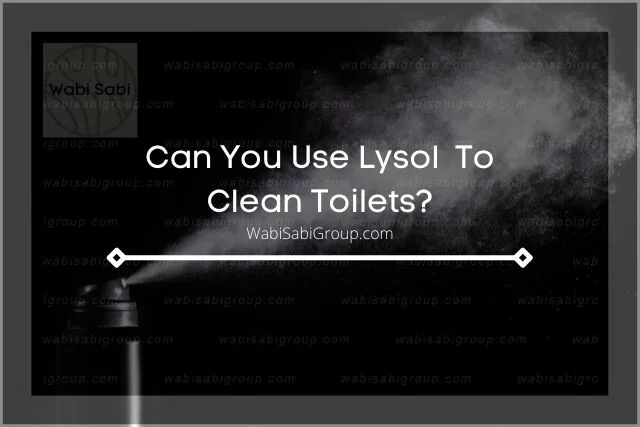
Lysol is a commonly used antiseptic and disinfectant liquid that is easy to use and thoroughly decontaminates any surface it’s applied on. However, can Lysol bear the high density of germs and bacteria sticking in the toilet bowl?
Well, yes, Lysol is one of the most effective ways of clearing your toilet from stains and stinky odors. While Lysol is not eco-friendly since it contains ethanol hydrogen peroxide, it still de-odorizes the toilet bowl and disinfects the surface, making it highly effective and easy to use.
How to Clean Your Toilet With Lysol Toilet Bowl Cleaner
While Lysol isn’t an eco-friendly toilet cleaner, it still is a great choice when it comes to getting rid of stains and odors from your toilet bowl. Here’s the proper procedure for using Lysol to clean your dirty toilets:
Step 1: Apply a generous amount of liquid directly onto the tough stains in your toilet. There’s no need to dilute Lysol since it’s already the perfect solution.
Step 2: If your toilet faces severe rust stains, it’s preferable to remove all water from the toilet bowl before proceeding further. You can do this by clogging the toilet and draining away all the water inside.
Step 3: Once you’ve drenched your toilet bowl with Lysol, it’s time to scrub thoroughly and let the solution rest for at least five minutes. It’s important to not close the lid at this stage so the chemical vapors don’t damage or abrase the lid of your toilet
Step 4: Finally, flush the toilet and rinse your toilet brush in freshwater after use.
This article and its contents are owned by Wabi Sabi Group and was first published on 06/13/2022.
Can You Use Clorox To Clean Toilet?
Clorox is one of the most efficient household cleaning solutions available on the market. Composed of strong bleach, Clorox kills 99.9% of germs in just under five minutes when applied to any surface. Read on to find out if it can maintain the hygiene of your toilet as well!
Yes, the strong household cleaner contains bleach and a powerful clinging gel that removes tough stains and deodorizes the toilet in no time. Moreover, it’s fairly easy to use as all you need to do is pour it into your toilet, wait a couple of minutes and flush the stains away.
Clorox Versus Lysol
Clorox and Lysol are two of the leading cleaning agents available on the market. However, they differ in their compositions as well as their cleaning capabilities.
| Clorox | Lysol |
| Contains bleaching gel | Contains ethanol and hydrogen peroxide |
| Removes tough stains easily | Kills 99.9% of bacteria and microorganisms. |
| Easy apply nozzle cap | Easy pour bottle design |
| Less harmful to plastic components | Corrosive nature can decolorize plastic |
Can You Use Dawn To Clean Toilet?
Most cleaning agents are rather too expensive to use regularly. However, Dawn is a great alternative as it gets the job done at a fairly economical price. But the question stands, is Dawn effective at bringing your dirty toilet back to life?
Yes, Dawn dish soap is a great eco-friendly alternative to other costly toilet cleaners. With three times more cutting power than a regular cleaner, Dawn rejuvenates your toilet by removing any visible stains. However, Dawn can be harmful to other components of your toilet due to its corrosive nature, so you have to be careful while using it.
Correct Method Of Using Dawn To Clean Toilet
While Dawn is an incredibly efficient cleaning agent, there is one catch to be mindful of: it has certain abrasive properties that can damage the plastic of your toilet seat. Therefore it’s essential to follow proper guidelines while using Dawn as your toilet cleaner.
Step 1: Grab a bowl and fill it with two parts Dawn and one part water. This will allow the solution to get diluted and become less damaging to your toilet.
Step 2: Next up, fill up a spray bottle with your prepared solution and start showering it on your toilet bowl.
Step 3: Let the solution sit for a couple of minutes before scrubbing it down with your toilet brush.
Step 4: Once you’ve scrubbed out all the stains, simply rinse your toilet bowl to flush away all the bacteria present.
Once done, you’ll be met with a sparkling clean toilet bowl free from germs and stinky odors!
This article and its contents are owned by Wabi Sabi Group and was first published on 06/13/2022.
Can You Use Citric Acid To Clean Toilet?
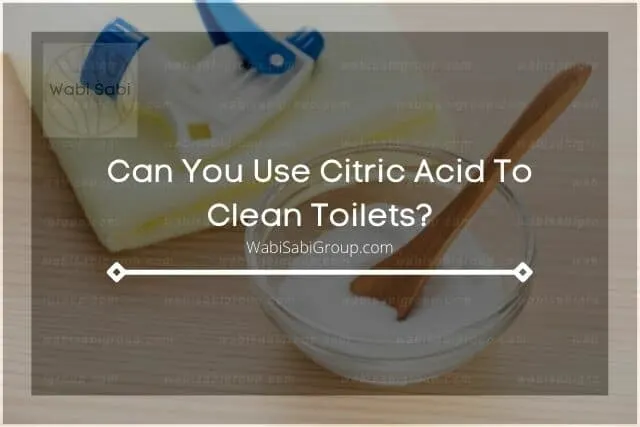
Citric acid is often hailed as nature’s most diverse cleaning agent, owing to its immense bacteria-killing properties. This eco-friendly option is also great for degreasing and whitening marble and porcelain, meaning it should be a viable toilet cleaning alternative too?
Yes, citric acid completely decontaminates your toilet and prevents decolorization of your toilet bowl over time. In addition, it replaces the unpleasant odors with a relaxing and fruitful scent. However, as a natural cleaning agent, it may not be as strong as industrial cleaners.
How To Clean Your Toilet With Citric Acid
Since citric acid isn’t as effective as special toilet cleaners, it does take a bit of effort trying to rub off all the stains on your toilet. However, failing the correct application procedure may make things a lot easier.
Step 1: Flush your toilet to clean any scum residue. This also helps to dampen the walls of the toilet bowl which enables the citric acid to stick to the surface and not fall down into the flush.
Step 2: Next, sprinkle citric acid generously onto the wet walls of the toilet. Make sure that the citric acid is sticking to the walls; you’ll probably see a paste forming at this point.
Step 3: Now pick up your toilet brush, run it through fresh water and start scrubbing the inners of your toilet bowl. Do remember to scrub under the rim as it’s most prone to contamination.
Step 4: Once you’re done scrubbing, let the solution rest on the toilet bowl for a couple of hours before flushing the toilet.
Can You Use Pumice Stone To Clean Toilet?
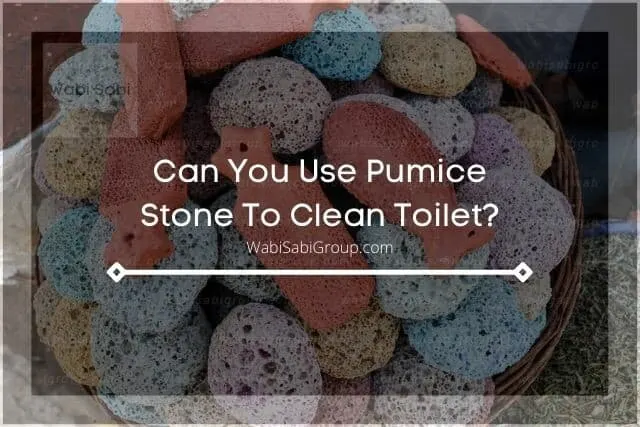
Pumice is a light yet abrasive stone that is quite effective for cleaning porcelain surfaces without scratching them. Being eco-friendly, the stone actually uses its salts rather than strong chemicals to take off stains and grease from most surfaces. However, is the pumice stone safe to use when it comes to cleaning your toilet?
Yes, a pumice stone or stick is an inexpensive yet effective toilet cleaning tool that requires no extra chemicals to reach its purpose. However, some people do not recommend using Pumice stone because it can easily scratch the surface of your toilet bowl if it’s used harshly.
Guide On How To Use Pumice Stone On Toilet
Being a light and porous stone in nature, pumice must be used through a specific channel in order to avoid damage to your toilet or even breaking the stone itself. Here are the necessary steps you should opt for while using your pumice stone for cleaning:
Step 1: Start off by spraying water on both, your pumice stone and your toilet bowl. This will help reduce friction and prevent your toilet from getting scratched during the process.
Step 2: Scrub the stains inside your toilet bowl with the help of your pumice stone. Apply even pressure and scrub in a circular or back-and-forth motion to achieve the best results.
Step 3: You’ll start seeing a gray-ish paste form on the toilet bowl – this means you’re on the right track. Keep scrubbing until you’re satisfied with your toilet’s condition.
Step 4: Once done, flush the toilet to rinse away any residue from the pumice stone, and viola! You’ll be looking at a sparkling clean toilet bowl!
Can You Use Hydrogen Peroxide To Clean Toilets?
Hydrogen peroxide is a perfect disinfectant as it effectively kills most bacteria and disease-causing germs. Does this mean, however, that it can get rid of tough stains from your toilet bowl?
Yes, hydrogen peroxide is a great cleaning agent to clean your toilet bowl from germs and stains. Its acidic nature acts as a perfect disinfectant for bacteria while it’s also corrosive so you have to be careful while using it. Moreover, it’s not an eco-friendly cleaner because it raises the acidity of water making it unusable.
This article and its contents are owned by Wabi Sabi Group and was first published on 06/13/2022.
Benefits Of Hydrogen Peroxide Cleaning
While there are so many safer alternatives than hydrogen peroxide, why should you use it for your toilet? Well, the answer(s) are simple:
- All-purpose cleaner: Hydrogen peroxide is an all-purpose cleaner and with the help of its germ-fighting properties, it sums up as an excellent option for wiping down every grimy surface in your bathroom.
- Deep Clean Toilets: Hydrogen peroxide can zap germs in your toilet bowl. Try pouring 1/2 cup hydrogen peroxide into the toilet and let the mixture sit for 15 minutes. After that, give it a good scrub and flush away the harmful bacteria.
- Give New Life To Old Porcelain: Porcelain toilets and sinks can build up calcium and start to turn yellow over time. However, hydrogen peroxide effortlessly brightens them up, requiring only a few drops to do its magic!
- All-purpose cleaner: Hydrogen peroxide is an all-purpose cleaner and with the help of its germ-fighting properties, it sums up as an excellent option for wiping down every grimy surface in your bathroom.
- Deep Clean Toilets: Hydrogen peroxide can zap germs in your toilet bowl. Try pouring 1/2 cup hydrogen peroxide into the toilet and let the mixture sit for 15 minutes. After that, give it a good scrub and flush away the harmful bacteria.
- Give New Life To Old Porcelain: Porcelain toilets and sinks can build up calcium and start to turn yellow over time. However, hydrogen peroxide effortlessly brightens them up, requiring only a few drops to do its magic!
- All-purpose cleaner: Hydrogen peroxide is an all-purpose cleaner and with the help of its germ-fighting properties, it sums up as an excellent option for wiping down every grimy surface in your bathroom.
- Deep Clean Toilets: Hydrogen peroxide can zap germs in your toilet bowl. Try pouring 1/2 cup hydrogen peroxide into the toilet and let the mixture sit for 15 minutes. After that, give it a good scrub and flush away the harmful bacteria.
- Give New Life To Old Porcelain: Porcelain toilets and sinks can build up calcium and start to turn yellow over time. However, hydrogen peroxide effortlessly brightens them up, requiring only a few drops to do its magic!
Can You Use Lemon To Clean Toilets?
Lemons are a natural and effective way to clean stains and disinfect surfaces. Moreover, the citrus fruit gives off a strong but pleasant scent after application, completely deodorizing the surfaces. However, are the cleaning capabilities of lemon any match against your stain-filled toilets?
Yes, lemon is a perfectly natural and eco-friendly way to rid your toilet from germs and stains. The fruit contains a high amount of citric acid which decomposes all bacteria and tough stains residing in your toilet bowl.
How To Clean Your Toilet With Lemon
Lemon isn’t a very strong cleaning agent and often requires a lot of effort to effectively clean your toilet. However, if you’re following the proper procedure, things could get a lot easier.
Step 1: To start off, grab your lemon juice and pour it into a spray bottle. For better results, you can also throw in some baking powder into the equation.
Step 2: Spray down your toilet bowl with your prepared lemon juice and let it sit for a couple of minutes before you start scrubbing. This will allow the stains to soften up, making the scrubbing process easier.
Step 3: Now start scrubbing the applied solution with your toilet brush. Also, remember to keep on spraying lemon juice if the toilet seat gets dry.
Step 4: Once you’ve scrubbed your toilet bowl thoroughly, flush your toilet to get a shiny clean surface and a pleasant lemony scent.
Can You Use Ammonia To Clean Toilets?
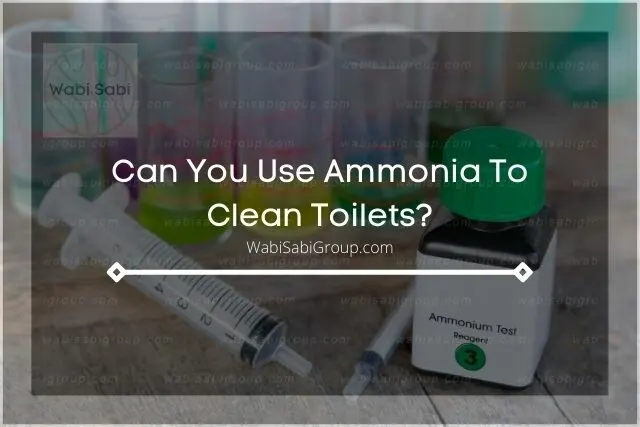
Ammonia is an effective cleaner for many surfaces as it easily breaks down stains and grease marks. Moreover, the evaporating quality of the ammonia allows it to clean shiny surfaces without leaving any streaks or marks. Nevertheless, does this make it safe to use as a toilet cleaner?
While ammonia does decontaminate your toilet bowl from most bacteria and germs, we wouldn’t recommend using it. Ammonia is strongly alkaline which decolorizes your toilet bowls and can damage your plastic-made toilet seat. This makes the solution more harmful than helpful.
Disadvantages Of Using Ammonia To Clean Toilets
Ammonia is definitely not recommended to clean porcelain and plastic-made objects. However, what makes it so harmful to use?
- Exposure to highly concentrated ammonia can cause severe burns as it is extremely corrosive in nature. Therefore, it’s a hassle to use in regular cleaning and also a hazard to keep if you have children at home.
- Ammonia can decolorize and even dissolve plastics and other materials quite easily. This can end up costing you a fair amount if your toilet seat becomes a mush of plastic after you’re done cleaning.
- If inhaled during cleaning, ammonia can lead to irritating throat and nose and could also lead to severe throat burns. Moreover, people with lung diseases would struggle to use the solution without protective equipment.
- Exposure to highly concentrated ammonia can cause severe burns as it is extremely corrosive in nature. Therefore, it’s a hassle to use in regular cleaning and also a hazard to keep if you have children at home.
- Ammonia can decolorize and even dissolve plastics and other materials quite easily. This can end up costing you a fair amount if your toilet seat becomes a mush of plastic after you’re done cleaning.
- If inhaled during cleaning, ammonia can lead to irritating throat and nose and could also lead to severe throat burns. Moreover, people with lung diseases would struggle to use the solution without protective equipment.
- Exposure to highly concentrated ammonia can cause severe burns as it is extremely corrosive in nature. Therefore, it’s a hassle to use in regular cleaning and also a hazard to keep if you have children at home.
- Ammonia can decolorize and even dissolve plastics and other materials quite easily. This can end up costing you a fair amount if your toilet seat becomes a mush of plastic after you’re done cleaning.
- If inhaled during cleaning, ammonia can lead to irritating throat and nose and could also lead to severe throat burns. Moreover, people with lung diseases would struggle to use the solution without protective equipment.
How To Clean A Toilet With An Eco-Friendly Cleaner Correctly
Cleaning your toilet with an authentic, eco-friendly and decontaminating cleaner is the basis of maintaining hygiene and health. As we use toilets regularly, it’s fair to assume that we would want them to be spick and span.
To keep your toilet spotless, you’ll need a quality toilet cleaner, a toilet brush, and a pair of hand gloves. Simply spray down your toilet with your toilet cleaner, scrub away any stains or debris and flush away all the bacteria.
This article and its contents are owned by Wabi Sabi Group and was first published on 06/13/2022.
This content is owned by Wabi Sabi Group and was first published on Jun 13, 2022..
Step-By-Step Guide On Cleaning Toilets Properly
The steps to cleaning your toilet with an effective toilet cleaner are quite simple. However, following the correct method may not only save you time but also provide better results.
Find a quality toilet cleaner: The first step is to invest in a high-quality toilet cleaner. A good cleaner should be environmentally-safe, ammonia-free, and efficient in taking off dirt and stains from your toilet bowl.
Dampen the toilet: Before proceeding, make sure to rinse the toilet by flushing. This softens up stains and debris, making the procedure much easier.
Apply and scrub: Now, spray down your eco-friendly toilet cleaner in your toilet bowl and start scrubbing with your toilet brush. Make sure to scrub under the rim as that’s where most bacteria reside!
Let it stay and soak: Once you’re satisfied with your scrubbing, let the solution soak inside your toilet bowl for a couple of minutes. You can also follow your toilet cleaner’s instructions to know the exact period of time you should wait before the next step.
This article was first published on Jun 13, 2022 by Wabi Sabi Group..
Flush Away: Finally, flush your toilet to get rid of all the impurities and achieve a spotless and germ-free porcelain surface!
Related Articles
What Can You Use To Clean Bathroom Sink/Drain
What Can You Use To Clean Soap Scum?
What Can You Use To Clean a Shower Curtain?
What Can You Use To Clean Shower Glass?
WabiSabi Group is the owner of this article and was published on Jun 13, 2022 and last modified on .
